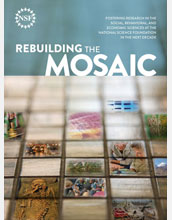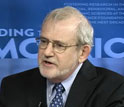News Release 11-253
"Mosaic Report" Outlines Strategies and Priorities for Future Social, Behavioral and Economic Sciences
New report says future social science research will be interdisciplinary, data-intensive and collaborative

More than 240 authors and teams of authors collaborated on NSF's report.
December 1, 2011
View a webcast with Dr. Myron Gutmann, assistant director for Social, Behavioral and Economic Sciences at NSF.
This material is available primarily for archival purposes. Telephone numbers or other contact information may be out of date; please see current contact information at media contacts.
The National Science Foundation's (NSF) Directorate for Social, Behavioral and Economic (SBE) Sciences, on Thursday, announced the findings of a year-long study that may chart the course of federally-funded social science research for the near future and beyond.
Called Rebuilding the Mosaic: Fostering Research in the Social, Behavioral, and Economic Sciences at the National Science Foundation in the Next Decade, the report results from a visioning process launched by the directorate in August 2010. It concludes NSF's existing programs serve the social science communities well and new topics, especially multidisciplinary ones, may invite a more flexible structure for future funding.
"'Rebuilding the Mosaic' is a commendable outcome of a herculean and very timely effort," said NSF Director Subra Suresh. "The information and thinking within the community--and reflected in the report--promise significant impact on science, NSF, and the nation's wellbeing."
More than 240 authors and teams of authors from the wider SBE community responded to an open invitation from NSF to contribute white papers that set forth the big questions that are likely to drive next generation research in social, behavioral and economic sciences; drive the kinds of skills and training future scholars will need to undertake this research; and drive the infrastructure of data, services and support required to enable future social research.
Within the rich diversity topics described in the 252 white papers received, the report finds SBE scientists share of a vision of research that is interdisciplinary, data-intensive and collaborative. It also finds the social science community looks to NSF's SBE directorate to provide the leadership and direction in building the capacity and infrastructure that will make future research possible.
The report includes definitive work on how behavioral, social and economic sciences can contribute significantly to understanding critical issues ranging from brain and behavior; creativity and innovation; crisis and disaster prevention/management; education and learning; social network dynamics; and to many other topics of critical importance to increasingly interconnected world communities.
"We have the opportunity to transform SBE over the next decade by creating a new generation of researchers and by providing them with the research programs, data and working environments in which to answer critical questions," said Myron P. Gutmann, NSF assistant director for SBE.
"'Rebuilding the Mosaic' is a remarkable report, said AnnaLee Saxenian, a professor and dean of University of California, Berkeley's School of Information. "It summarizes crowd sourced input from the diverse communities served by the NSF's SBE directorate [and] it recognizes that the directorate needs to reinvent itself and the research enterprise for new technological and global realities."
"This is a genuinely refreshing reorientation and refocusing that bodes well for social science research in the 21st Century," said Saxenian, who chairs NSF's Board of Advisors for SBE.
Beginning in 2012, the SBE directorate will move forward on three parallel tracks: refining priorities for the content of SBE science; exploring ways to develop the capacity to conduct this work through fellowships, mentoring, and training programs; and advancing the infrastructure of services, facilities and data that forms the platform from which the science can be undertaken.
The "Rebuilding the Mosaic" report is available online at NSF's website together with all 252 white papers, supporting materials and an archived copy of the town hall webcast today, in which Gutmann discusses the report and its implications.
-NSF-
-
View Video
Myron Gutmann discusses NSF's future priorities for social science research funding.
Credit and Larger Version
Media Contacts
Bobbie Mixon, NSF, (703) 292-8485, email: bmixon@nsf.gov
Program Contacts
Amy Friedlander, NSF, (703) 292-2262, email: afriedla@nsf.gov
Related Websites
Rebuilding the Mosaic Report: http://www.nsf.gov/pubs/2011/nsf11086/nsf11086.pdf
The U.S. National Science Foundation propels the nation forward by advancing fundamental research in all fields of science and engineering. NSF supports research and people by providing facilities, instruments and funding to support their ingenuity and sustain the U.S. as a global leader in research and innovation. With a fiscal year 2023 budget of $9.5 billion, NSF funds reach all 50 states through grants to nearly 2,000 colleges, universities and institutions. Each year, NSF receives more than 40,000 competitive proposals and makes about 11,000 new awards. Those awards include support for cooperative research with industry, Arctic and Antarctic research and operations, and U.S. participation in international scientific efforts.
Connect with us online
NSF website: nsf.gov
NSF News: nsf.gov/news
For News Media: nsf.gov/news/newsroom
Statistics: nsf.gov/statistics/
Awards database: nsf.gov/awardsearch/
Follow us on social
Twitter: twitter.com/NSF
Facebook: facebook.com/US.NSF
Instagram: instagram.com/nsfgov

